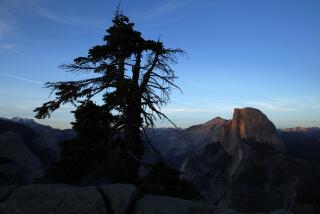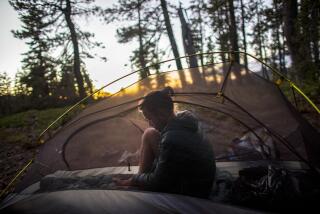Risk Factor Rising to Unsafe Level for American Outdoorsman
WASHINGTON — When Farwell Smith, fund-raiser for the Wilderness Society in Washington and an outdoorsman most of his life, took a trip to visit island villages near Vancouver, British Columbia, two years ago, he didn’t expect to end up on a life raft.
Smith, a former merchant seaman, considered the 90-foot converted shrimper he boarded safe for his group of 20 mostly elderly people, but he was surprised at the apparent ineptitude of the crew, thrown together by the travel agency that chartered the boat.
“I knew the crew was woefully inadequate,” said Smith, “but you don’t connect that sort of thing with sinking.”
That’s exactly what happened, in a storm in the middle of the 130-mile Hecate Straits.
Smith was helpful and lucky. He took the helm during the night-long gale while the captain prepared the life rafts, and Smith’s daughter Loren, 25, a world-class rower, helped organize the evacuation. In the end, rescuers came swiftly, and no one was injured.
“But I had to laugh,” said Smith. “I said, ‘I’m here for a quiet vacation. What the hell am I doing on a life raft?’ ”
What Smith was doing was staying alive, a challenge more and more Americans find themselves addressing as they turn to the outdoors and so-called “risk-adventure” sports for entertainment.
Outdoor recreation is a booming, $200-billion-a-year industry in the United States, according to the President’s Commission on Americans Outdoors. In a recent survey, the commission characterized 16% of U.S. adults as “excitement-seeking competitives” in outdoor sports.
Whether these people go whitewater rafting, mountaineering, ocean voyaging, hiking, rock climbing, hunting, fishing, diving, kayaking, hang gliding, winter camping or cross-country skiing, they are, as Smith and others have found out, exposing themselves to risk.
And trouble can happen to anyone. Just last week, a member of the President’s Commission on Americans Outdoors, Salley Ranney, fractured her spine in a snowmobile accident while touring the Snowy Range Mountains in Wyoming on official business.
Ed Darrell, the commission’s public affairs director, remembers serving on a panel investigating the case of a star Arizona State University football player who died on a school recreation class trip when he fell out of his canoe on a flat-water stretch of the Colorado River.
“The man didn’t know how to swim, no one bothered to ask and he wasn’t wearing a life jacket,” said Darrell. “It was just a disaster waiting to happen.”
In this area, more than 55 persons have drowned in the Potomac River between Great Falls and Little Falls in the last decade, most of them rock hoppers, fishermen or novice boaters who misjudged the tremendous power of the river.
In the last two weeks, disasters focused new attention on the perils of outdoor recreation as seven teen-agers and two teachers froze to death in a snowstorm on Mount Hood in Oregon, and four hands from the clipper ship Pride of Baltimore apparently drowned in a sinking off Puerto Rico.
On the surface, these events could be blamed on cataclysmic acts of nature--a howling blizzard and a murderous squall. But for anyone who uses the outdoors, they raised familiar questions: Did people have to die? Did those in charge know what they were doing? Did warnings go unheeded? Were the groups reasonably prepared for the worst?
“When I set up a trip, I’m always playing, ‘What if?’ ” said Benji Simpson, director of Passages, a West Virginia outfitter specializing in whitewater rafting, mountaineering, ice-climbing and winter camping. “What if the weather changes? What if this guy flips his boat?
“You play the game because in doing adventures, people are going to get hurt, and you have to know what to do when it happens.”
Simpson was one of several outfitters, outdoorsmen, club safety officers and government officials interviewed last week in a look at the safety of the outdoor adventure industry in light of the recent accidents.
The picture that emerged is of an unpredictable patchwork of government controls on commercial guides and outfitters who lead adventures, an insurance problem that has gotten out of hand and, perhaps above all, a consensus that people who take up adventure sports have an obligation to acquaint themselves with the risks in advance and not leave all the decision-making to someone they hire.
“There’s a hell of a lot of people exposing themselves to a lot of risk,” said Smith, “and most of them don’t get hurt. But I, myself, am almost hysterically careful. I’ve seen what can happen.”
“People have the idea that when they hire an outfitter they are transferring the risk to him,” said Simpson, “but people have to be responsible for their own actions. I can take you skiing or rafting, but if you don’t pay attention, if you don’t paddle when I say paddle, that responsibility is yours.”
Simpson works in a state that rigorously oversees outfitters and guides. West Virginia law requires anyone who regularly accepts money for guiding, rents equipment or sells advice or any other outdoor-recreation service to register, post a bond, carry insurance and follow basic safety rules.
But in neighboring Virginia, “we don’t know who guides for what, except the guys who run charter boats and have Coast Guard licenses,” said Jack Randolph, assistant director of Game and Inland Fisheries.
In Maryland, waterfowl hunting guides and Chesapeake Bay charter boat operators are licensed, but no license is required for canoeing, rafting, hiking, camping, mountaineering, fishing, rock-climbing or any other outfitters.
Officials said this bewildering situation is typical of the outdoors trade, in which generally there is no federal oversight and official involvement depends on the states. “These activities are obviously growing,” said Randolph, “and it’s probably something we ought to look at.”
The way the industry is regulated is often by insurers, but lately insurance has grown so expensive, and in some cases unobtainable, that some outfitters are “going bare.”
For example, there is no longer commercial insurance available for rock-climbing instruction in the United States, according to John Dragan of Wildwater Unlimited in West Virginia.
The last remaining insurer dropped the sport this year as too dangerous, he said. Simpson said he has simply stopped guiding rock climbers, but other outfitters are pressing on without coverage, he said.
Insurance rates for other sports, including whitewater rafting, are soaring, Dragan said, “but at least we can still get it.”
And even in states where insurance and registration of guides are required, officials said locals lead trips without any official imprimatur. That was the case in the Mount Hood disaster, in which a local ski instructor, who was hired to help run the ascent, turned out neither to have a National Forest Service permit to guide such a trip nor to be registered as a mountaineering guide with the state.
Nonetheless, industry and government people agree that the safest way for nonexperts to participate in adventure sports is to go with a reputable guide or outfitter.
“In Eastern river sports,” said Charlie Walbridge, the American Canoe Assn. safety chairman, “there have been very few fatalities of people traveling with professional outfitters--maybe four in the last 15 years, and you’re talking about hundreds of thousands of people.
“There are two ways of getting involved in river-running,” he said. “One is to make a commitment, maybe join a club, and gradually work your way up to the limits of your skill. The other is to make no commitment, just go out and go down a river.
“For this (latter) type, going with a professional guide is the safest way,” said Walbridge, “but it certainly does not remove the risk, even with a good outfitter. When you play with Mother Nature, you can control the risk but you can never eliminate it.”
In mountaineering, as in whitewater river-running, “It’s clear that those who operate without professional guides get into a lot more trouble,” said Jed Williamson, who compiles an annual report on all major mountaineering accidents as safety officer of the American Alpine Club.
What can average people do to make sure the professionals they hire are offering a reasonably safe experience?
Use common sense, say the people in the trade.
“You ask questions,” said Simpson. “If I hire somebody to take me scuba diving or hang-gliding, I want everything I do explained to me first. You’re not going to just give me a tank and mask and tell me to jump overboard. I want to know how everything works, and why.
“When you go with an outfitter, you check: Do they have to be accredited or certified? Are they? How long have they been in the business? Who specifically is going to be teaching me? What’s his experience?”
Outfitters themselves are looking for ways to reduce risks, particularly in view of the insurance crisis.
“A lot of what we do is perceived high-risk rather than actual,” said Chuck Ackenbom, who runs an adventure camp for youngsters near Charlottesville, Va. “I certainly wouldn’t say this to our campers, but what we do is watered down and made safer than it initially appears. We go hang-gliding, but on sand dunes; we’re whitewater canoeing essentially on Class I and II (gentle) streams; we’re rafting moderate whitewater, not the wild stuff.”
More to Read
Sign up for The Wild
We’ll help you find the best places to hike, bike and run, as well as the perfect silent spots for meditation and yoga.
You may occasionally receive promotional content from the Los Angeles Times.






